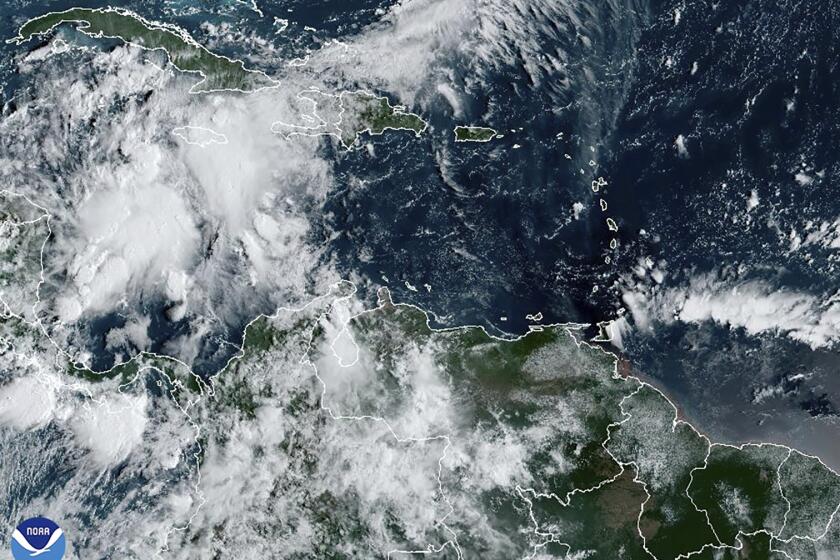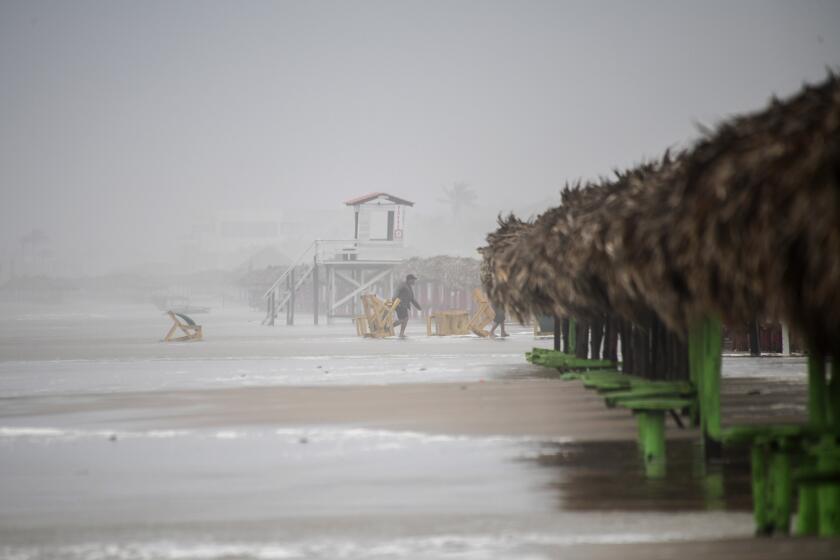Hurricane Helene strengthens to Category 4 along Florida’s Gulf Coast

CRAWFORDVILLE, Fla. — High winds began battering Florida on Thursday as Hurricane Helene, now a Category 4, was poised to make landfall, with forecasters warning that the enormous storm could create a “nightmare” surge along the coast and churn up damaging winds hundreds of miles inland across much of the southeastern U.S.
Helene was upgraded Thursday evening ahead of its expected evening landfall on Florida’s northwestern coast. Hurricane and flash flood warnings extend far beyond the coast up into northern Georgia and western North Carolina. The governors of Florida, Georgia, the Carolinas and Virginia have all declared emergencies in their states.
It was starting to be felt Thursday afternoon, with water lapping over a road on the northern tip of Siesta Key near Sarasota and covering some intersections in St. Pete Beach along Florida’s Gulf Coast. The winds already have left about 180,000 Florida homes and businesses without power in the state.
President Biden is sending the head of the Federal Emergency Management Agency to Florida on Friday to view the damage.
Beyond Florida, up to 10 inches of rain has fallen in the North Carolina mountains, with up to 14 more possible before the deluge ends, setting the stage for flooding that forecasters warned could be worse than anything seen in the last century.
Florida Gov. Ron DeSantis said Thursday morning that models suggest Helene will make landfall farther east, lessening the chances for a direct hit on the capital city of Tallahassee, whose metro area has a population of about 395,000.
The shift has the storm aimed squarely at the sparsely populated Big Bend area, home to fishing villages and vacation hideaways where Florida’s Panhandle and peninsula meet.
“Please write your name, birthday, and important information on your arm or leg in a PERMANENT MARKER so that you can be identified and family notified,” the sheriff’s office in mostly rural Taylor County warned those who chose not to evacuate in a Facebook post, the dire advice similar to what other officials have doled out during past hurricanes.
Forecasters are warning that huge Hurricane Helene will intensify in the Gulf of Mexico before making landfall in Florida.
Philip Tooke, a commercial fisherman who took over the business his father founded near the region’s Apalachee Bay, plans to ride out this storm as he did during Hurricane Michael and the others — on his boat. “This is what pays my bills,” Tooke said of his boats. “If I lose that, I don’t have anything.”
Many, though, were heeding the mandatory evacuation orders that stretched from the Panhandle south along the Gulf Coast in low-lying areas around Tallahassee, Gainesville, Cedar Key, Lake City, Tampa and Sarasota.
Among them was Sharonda Davis, one of several gathered at a Tallahassee shelter worried their mobile homes wouldn’t withstand the winds. She said the hurricane’s size is “scarier than anything because it’s the aftermath that we’re going to have to face.”
Federal authorities were staging search-and-rescue teams as the National Weather Service office in Tallahassee forecast storm surges of up to 20 feet and warned they could be particularly “catastrophic and unsurvivable” in Apalachee Bay.
“Please, please, please take any evacuation orders seriously!” the office said, describing the surge scenario as “a nightmare.”
This stretch of Florida known as the Forgotten Coast has been largely spared from the widespread condo development and commercialization that dominate so many of Florida’s beach communities. The region is loved for its natural wonders — the vast stretches of salt marshes, tidal pools and barrier islands.
“You live down here, you run the risk of losing everything to a bad storm,” said Anthony Godwin, 20, who lives about a half-mile from the water in the coastal town of Panacea, as he stopped for gas before heading west toward his sister’s house in Pensacola.
Tropical Storm Helene has formed in the Caribbean Sea, and forecasters say it will strengthen into a major hurricane.
Along Florida’s Gulf Coast, school districts and multiple universities have canceled classes. Airports in Tampa, Tallahassee and Clearwater were closed Thursday, and cancellations were widespread elsewhere in the state and beyond.
Although Helene probably will weaken as it moves inland, damaging winds were expected to extend to the southern Appalachian Mountains, where landslides were possible, forecasters said. Lesser tropical storm warnings were posted as far north as North Carolina, and officials warned that much of the region could experience prolonged power outages and flooding. Tennessee was among the states expected to get drenched.
Helene had swamped parts of Mexico’s Yucatan Peninsula on Wednesday, flooding streets and toppling trees as it passed offshore and brushed the resort city of Cancun.
The storm formed Tuesday in the Caribbean Sea. In western Cuba, Helene knocked out power to more than 200,000 homes and businesses as it brushed past the island.
Helene is forecast to be one of the largest storms in breadth in years to hit the region, said Colorado State University hurricane researcher Phil Klotzbach. He said since 1988, only three gulf hurricanes were bigger than Helene’s predicted size: 2017’s Irma, 2005’s Wilma and 1995’s Opal.
Areas 100 miles north of the Georgia-Florida line can expect hurricane conditions. More than half of Georgia’s public school districts and several universities canceled classes. The state has opened its parks to evacuees and their pets, including horses.
For Atlanta, Helene could be the worst strike on a major Southern inland city in 35 years, said University of Georgia meteorology professor Marshall Shepherd.
More than 200 miles to the south, some businesses in the inland city of Valdosta, Ga., closed because of the hurricane warning, including the local Walmart.
“We know the Lord’s in control,” said 67-year-old Margaret Freenman, when she found pallets stacked high blocking the store’s entrances after showing up to buy snacks with her two grandchildren. “He’s got the last say.”
Debby, Oscar, Tony: What’s in a storm’s name? How does a tropical storm or hurricane get its moniker? Will yours come up on the forecasters’ list?
Helene is the eighth named storm of the Atlantic hurricane season, which began June 1. The National Oceanic and Atmospheric Administration has predicted an above-average Atlantic hurricane season this year because of record-warm ocean temperatures.
In further storm activity, Tropical Storm Isaac formed Wednesday in the Atlantic and was expected to strengthen as it moves eastward across the open ocean, possibly becoming a hurricane by the end of the week, forecasters said. Officials said its swells and winds could affect parts of Bermuda and eventually the Azores by the weekend.
In the Pacific, former Hurricane John reformed Wednesday as a tropical storm and strengthened Thursday morning back into a hurricane as it threatened areas of Mexico’s western coast with flash flooding and mudslides. Mexican President Andrés Manuel López Obrador raised John’s death toll to five Thursday as the communities along the country’s Pacific coast prepared for the storm to make a second landfall.
Payne and Hollingsworth write for the Associated Press. Hollingsworth reported from Mission, Kan. Associated Press journalists Seth Borenstein in New York; Jeff Amy in Atlanta; Danica Coto in San Juan, Puerto Rico; Andrea Rodríguez in Havana; Mark Stevenson and María Verza in Mexico City; and Claire Rush in Portland, Ore., contributed to this report.
More to Read
Sign up for Essential California
The most important California stories and recommendations in your inbox every morning.
You may occasionally receive promotional content from the Los Angeles Times.













